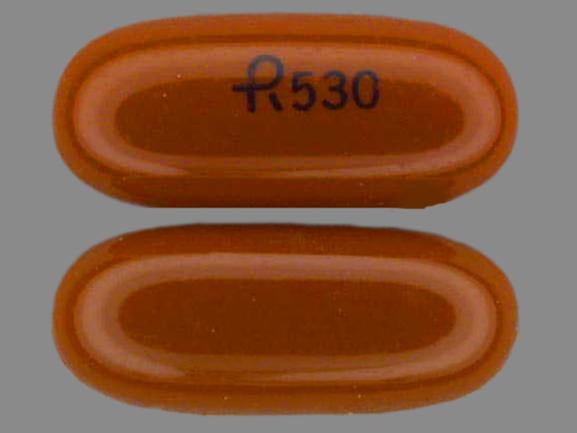R 530 Pill Nifedipine – Uses, Side Effects, and More
Nifedipine 20 mg is the name of the red, capsule-shaped, oblong pill with imprint R 530. Actavis is the supplier of it.
Nifedipine is a calcium channel blocker medication that is used to treat high blood pressure and prevent angina pectoris. Pregnancy cannot be considered risk-free. The Controlled Substances Act (CSA) does not classify 20 mg of nifedipine as a controlled substance.
Here’s the information in table format:
Here’s a table overview for the R 530 pill (Nifedipine 10 mg):
| Aspect | Details |
|---|---|
| Generic Name | Nifedipine |
| Imprint | R 530 |
| Strength | 10 mg |
| Appearance | Pink, round tablet |
| Drug Class | Calcium channel blocker |
| Primary Uses | – Treats high blood pressure (hypertension) – Manages chest pain (angina) |
| Mechanism of Action | Relaxes blood vessels and improves blood flow by inhibiting calcium entry into smooth muscle cells |
| Common Side Effects | – Dizziness – Flushing – Headache – Swelling in feet/ankles |
| Serious Side Effects | – Low blood pressure (hypotension) – Severe dizziness or fainting – Irregular heartbeat |
| Dosage Form | Immediate-release oral tablet |
| How to Take | Usually taken 3 times daily with or without food, as directed by a doctor |
| Precautions | – Avoid grapefruit and grapefruit juice – Monitor blood pressure regularly – Use with caution in heart-related conditions |
| Drug Interactions | May interact with beta-blockers, digoxin, and certain antifungals or antibiotics |
| Prescription Status | Prescription-only (Rx) |
| Manufacturer | Actavis Pharma, Inc. |
| Availability | Identified on PillRecognizer.com for confirmation |
This table provides a quick overview of the R 530 pill (Nifedipine 10 mg) and its key attributes. Always follow your doctor’s instructions for safe and effective use.
Understanding the R 530 Pill (Nifedipine 10 mg): Uses, Side Effects, and More
If you’ve come across a small, pink, round pill with the imprint R 530, you’re looking at Nifedipine 10 mg, a commonly prescribed medication for managing high blood pressure (hypertension) and chest pain (angina). In this blog, we’ll discuss how this pill works, its benefits, and what to watch out for when using it.
What is the R 530 Pill?
The R 530 pill contains Nifedipine, a calcium channel blocker that relaxes blood vessels and improves blood flow. This action helps reduce blood pressure and prevent chest pain caused by restricted blood flow to the heart.
You can identify this pill by its pink, round shape with “R 530” imprinted on one side. If you’re unsure about your medication, you can confirm its details on PillRecognizer.com, a reliable tool for pill identification.
Uses of the R 530 Pill (Nifedipine 10 mg)
- Treats High Blood Pressure (Hypertension): Nifedipine helps reduce the strain on your heart and lowers the risk of heart attacks and strokes.
- Manages Angina (Chest Pain): By improving blood flow, it prevents or reduces chest pain caused by restricted oxygen supply to the heart.
How to Take the R 530 Pill
- Dosage: Usually taken three times daily, as prescribed by your doctor.
- With or Without Food: Can be taken with or without meals.
- Avoid Grapefruit: Grapefruit and its juice can interfere with Nifedipine and increase the risk of side effects.
Common Side Effects of Nifedipine
While Nifedipine is effective, it can cause some side effects, such as:
- Dizziness or lightheadedness
- Flushing (warmth or redness in the face)
- Headache
- Swelling in the feet or ankles
If these symptoms persist or worsen, consult your doctor.
Serious Side Effects and Precautions
In rare cases, Nifedipine can cause serious side effects like:
- Severe low blood pressure (hypotension)
- Irregular heartbeat
- Fainting or severe dizziness
Precautions:
- Regularly monitor your blood pressure.
- Let your doctor know if you have heart-related issues or liver problems.
- Avoid sudden changes in posture (like standing up too quickly) to prevent dizziness.
Who Should Consider the R 530 Pill?
Nifedipine may be a good option for you if:
- You have high blood pressure that requires medication to control.
- You experience angina and need relief or prevention.
- You and your doctor agree that Nifedipine’s benefits outweigh any risks.
Why Pill Identification Matters
If you’re ever unsure about a pill, tools like PillRecognizer.com can help confirm its identity. This is especially useful for verifying medications like R 530 (Nifedipine 10 mg), ensuring you’re taking the right dose and avoiding errors.
Final Thoughts
The R 530 pill (Nifedipine 10 mg) is a valuable medication for managing high blood pressure and chest pain. By improving blood flow and reducing strain on your heart, it helps protect your long-term health. Always use Nifedipine as directed by your healthcare provider, and monitor for any side effects.
Have questions or experiences with the R 530 pill? Share your thoughts in the comments below! Together, we can support each other on the journey to better health.
Disclaimer: This blog is for informational purposes only. Always consult your doctor for personalized medical advice.
SEO Keywords:
- R 530 pill
- Nifedipine 10 mg uses
- R 530 pill side effects
- High blood pressure medication
- Is R 530 pill on PillRecognizer.com
- Calcium channel blocker pills
USES
Nifedipine belongs to a class of medications known as calcium channel blockers. It functions by letting your heart and blood vessel muscles relax.
Nifedipine is used to treat angina (chest discomfort) and hypertension (high blood pressure).
There are additional uses for nifedipine besides those specified in this pharmaceutical guide.
SIDE EFFECTS
If you have any of the following symptoms of a nifedipine allergy: hives; trouble breathing; swelling in your face, lips, tongue, or throat, get emergency medical attention.
Make a quick call to your doctor if you have:
angina that is becoming worse;
a sense of lightheadedness, as if you could faint;
heart palpitations or flutters in your chest;
nausea, perspiration, a heavy or painful feeling in the chest, pain that radiates to the jaw or shoulder, and an overall bad feeling;
edema in your feet or ankles; or
upper gastrointestinal discomfort, jaundice (skin or eye yellowing).
Typical nifedipine adverse effects could be:
slight vertigo
flushing (heat, redness, or prickling sensation);
a headache, weakness, and mood swings;
nausea, heartburn;
muscular spasms, tremors; or
cough, sore throat, congested nose, and wheezing.
The list of adverse effects is not exhaustive.

